
© Karolina Kuras. (Click image for larger version)
The National Ballet of Canada
The Sleeping Beauty
★★★★✰
Toronto, Four Seasons Centre for the Performing Arts
15 and 17 March 2018
national.ballet.ca
The National Ballet of Canada brought its opulent production of The Sleeping Beauty back to Toronto’s Four Seasons Centre for the Performing Arts in March for a twelve-performance run.
Steeped in the company’s history, this Sleeping Beauty is a real treasure – a lavishly-outfitted and deeply absorbing spectacle which bears the indelible imprint of its creator, the legendary Russian dancer Rudolf Nureyev.
“Petipa teaches. He is the basis of all ballet,” Nureyev used to say about Marius Petipa, creator of The Sleeping Beauty for the Imperial Ballet in St. Petersburg. For Nureyev, The Sleeping Beauty was the greatest and grandest of all the 19th-century classics – “the Parsifal of ballets.” He intimately knew the Tchaikovsky/Petipa masterpiece from his student years and his time with the Kirov Ballet (now the Mariinsky). It was the very first ballet he danced in the West (with the Kirov Ballet, at Paris’s Palais Garnier, in May 1961); and it was the first ballet he performed as a free man after making a life-changing decision not to return to the Soviet Union – that was with the de Cuevas company at the Chapms-Élysées Theater in June 1961.
When Nureyev got a chance to stage his own version of the classic, for La Scala in 1966, he made sure that his Sleeping Beauty had “all the resonance of grand opera.” There was no expense spared on his opulent staging to reflect the sense of majesty and splendor of the Russian Imperial Court that was inherent in the original ballet.
In 1972, Nureyev transplanted the production to Toronto, giving the then 21-year old National Ballet of Canada the chance of a lifetime. With this ballet, the little-known Canadian troupe traveled the world, with an annual three-week stop at the Metropolitan Opera House in New York, firmly establishing itself on the international dance scene.
Artistic director of the company Karen Kain calls it “serendipity.” She was only 20-years old – the youngest principal ballerina in the National Ballet’s history – when Nureyev recognized her talent and took her under his wing, becoming her teacher and “a guardian angel.” “We were all his disciples as young dancers, and there was no end to the generosity of spirit he had about educating us as artists,” she recalls her time under Nureyev’s guidance.
Keeping her mentor’s flame alive and honoring his artistic vision, Kain maintains this historic production in great shape. She remounted the ballet in 2004 and, two years later, gave Nureyev’s Beauty a $700,000 face-lift, refurbishing the decorations and restoring the wardrobe.
This Beauty is definitely worthy of preserving. It’s one of the best dressed productions of the classic I have ever seen. The costumes designed by Nicholas Georgiadis – and there are nearly 350 of them in this ballet – are breathtaking. From the luxurious attire for the royal couple to a dazzling collection of sumptuous tutus for the corps de ballet, the costumes are not only elaborate and rich in fabric and texture, they are ingeniously and stylishly made – each piece looks like a work of fashion art.
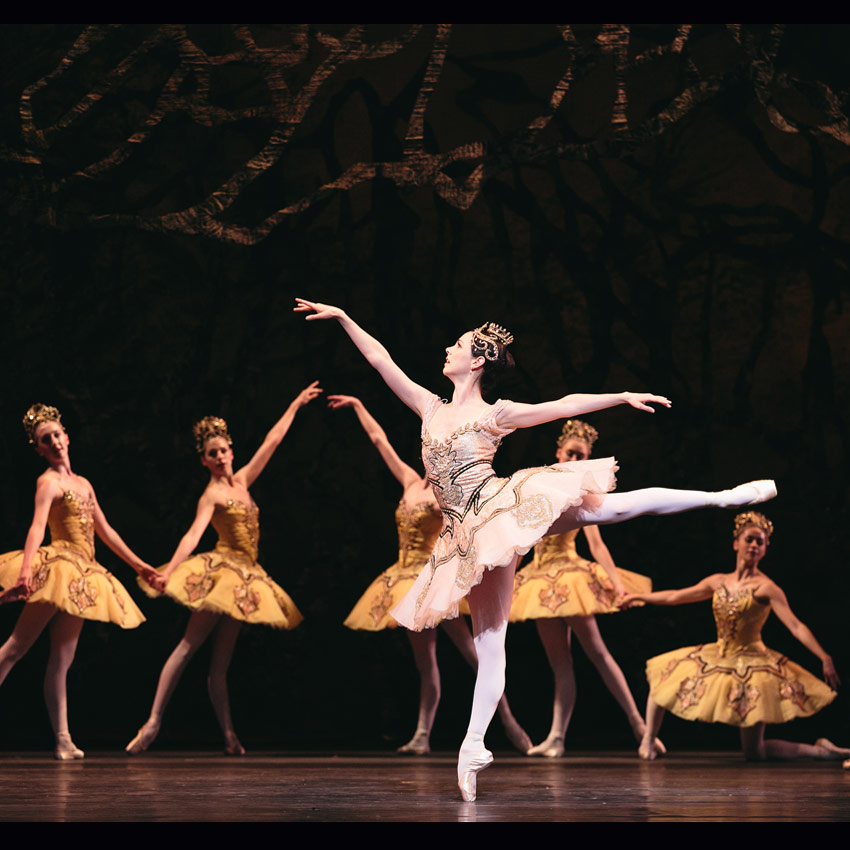
© Karolina Kuras. (Click image for larger version)
Stark and somewhat somber, the stage décor is dominated by a grand staircase in the Prologue and features a kaleidoscope of handsomely-painted backdrops that add to the overall sense of mystery and fairytale. The ever-changing decorations keep the action moving forward, transforming the stage, as if by magic, from the regal Royal Palace to the spacious hunting grounds to the ominous-looking forest in the Vision Scene and back to the grand ballroom of the Palace, where the culminating wedding celebration of Aurora and the Prince takes place.
In this production, the tale of Princess Aurora and her fateful curse is told in a simple and coherent manner, with each scene having its internal logic and narrative purpose, and every moment is a step towards the story’s happy resolution. One of the notable features of this staging is an abundance of clear and expressive pantomime which not only enhances the storytelling but also transforms the whole affair into gripping theatre.
The choreography follows the steps of Marius Petipa in most of the key scenes of the ballet, such as the Rose Adagio, fairies variations, the Bluebird pas de deux, and the wedding grand pas de deux; but it wouldn’t be a Nureyev production without his personal artistic stamp.
The most striking feature of his staging is the significant expansion of the role of the Prince (which was conceived as a showcase for Nureyev himself). Here, the Prince is no longer a mere carrier of a ballerina, but a prominent personage, with plenty of dancing opportunities to demonstrate his technical skills and to reveal his emotional feelings. By giving the Prince more stage time, Nureyev not only allotted extra room for male bravura dancing but also rendered His Royal Highness as a true romantic hero, turning this fairytale into a poignant and genuine love story.
Still, The Sleeping Beauty is Aurora’s ballet, and the two performances I saw were blessed with an exquisite Aurora. Canada’s own Jillian Vanstone was everything that a young Princess should be and then some. Her Aurora exuded radiance, joy and special warmth from the first moment she appeared onstage during the birthday festivities in Act I. A stellar technician, Vanstone was in complete command of the choreography’s technical demands. To watch Aurora in action is to understand why this Beauty is deemed as one of the hardest productions to dance. She was poised and assured during the famous Rose Adagio, gliding from one impeccable balance to another with an appealing grandness and effervescence. In the second act’s Vision Scene, her movements – lyrical, measured and utterly expressive – acquired serene luminosity. Watching her dance, you could feel her Aurora was falling in love with the Prince, longing for his affection and beckoning him to come to her rescue.
On March 15, the role of Prince Florimund was performed by Harrison James. There are five arduous solos instead of the customary one, each full of intricate footwork and virtuosic jumps and turns for the Prince to tackle in this production. James proved to be up to the challenges, conquering the technical hurdles of the choreography with exactitude and aplomb. He made a particular impression in his melancholic soliloquy during the second act’s Hunting Scene, imbuing his languid dancing with a touch of romantic longing. His was a young man, looking for meaning in life and yearning for true love. His partnering was top-notch; and there was a palpable chemistry between his Prince and Vanstone’s Aurora. Their grand pas de deux in the final act felt not only a victory of light over darkness but also a triumph of the power of love.

© Aleksandar Antonijevic. (Click image for larger version)
On March 17 (which would have been Nureyev’s 80th birthday), the company’s first soloist, Francesco Gabriele Frola, danced the role of the Prince. With his boyish good looks and amiable personality, Frola turned Aurora’s husband-to-be into a real heartthrob. A prodigious talent, Frola sailed with ease through his part’s complexities, demonstrating a flair for fluid phrasing and high jumps. His solos felt like a firework of youthful exuberance; and his assured partnering during the wedding festivities galvanized and inspired Vanstone’s Aurora.
As the wicked fairy Carabosse, Alejandra Perez-Gomez reveled in the role’s theatrical excesses. In this production, Carabosse is every inch a glamorous lady, clad in a striking gown in black, red and gold, and wearing a golden crown for a headpiece. Perez-Gomez delivered her pantomime scenes with relish and an appropriately exaggerated dramatic intensity. Her vindictive outrage looked at once believable and terrifying, and it was up to Stephanie Hutchison’s Lilac Fairy to undo her destructive curse and restore peace and order in the Kingdom. This is a mime role (another quirk of this production) and Hutchison gave this part full measure; her every gesture projected assurance, calm and authority.
From the assorted fairies, Emma Hawes stood out in as the Principal Fairy on March 17; and Elena Lobsanova shone in the Third Variation on both nights.
The wedding divertissements comprised the Bluebird Pas de Deux, Pussycats duet, and Pas de Cinq led by Diamond Man and Diamond Lady. There were many memorable turns here as well, including Hannah Fischer’s Diamond Lady (March 17), Tina Pereira’s Princess Florine (March 15) and Miyoko Koyasu’s Pussycat.
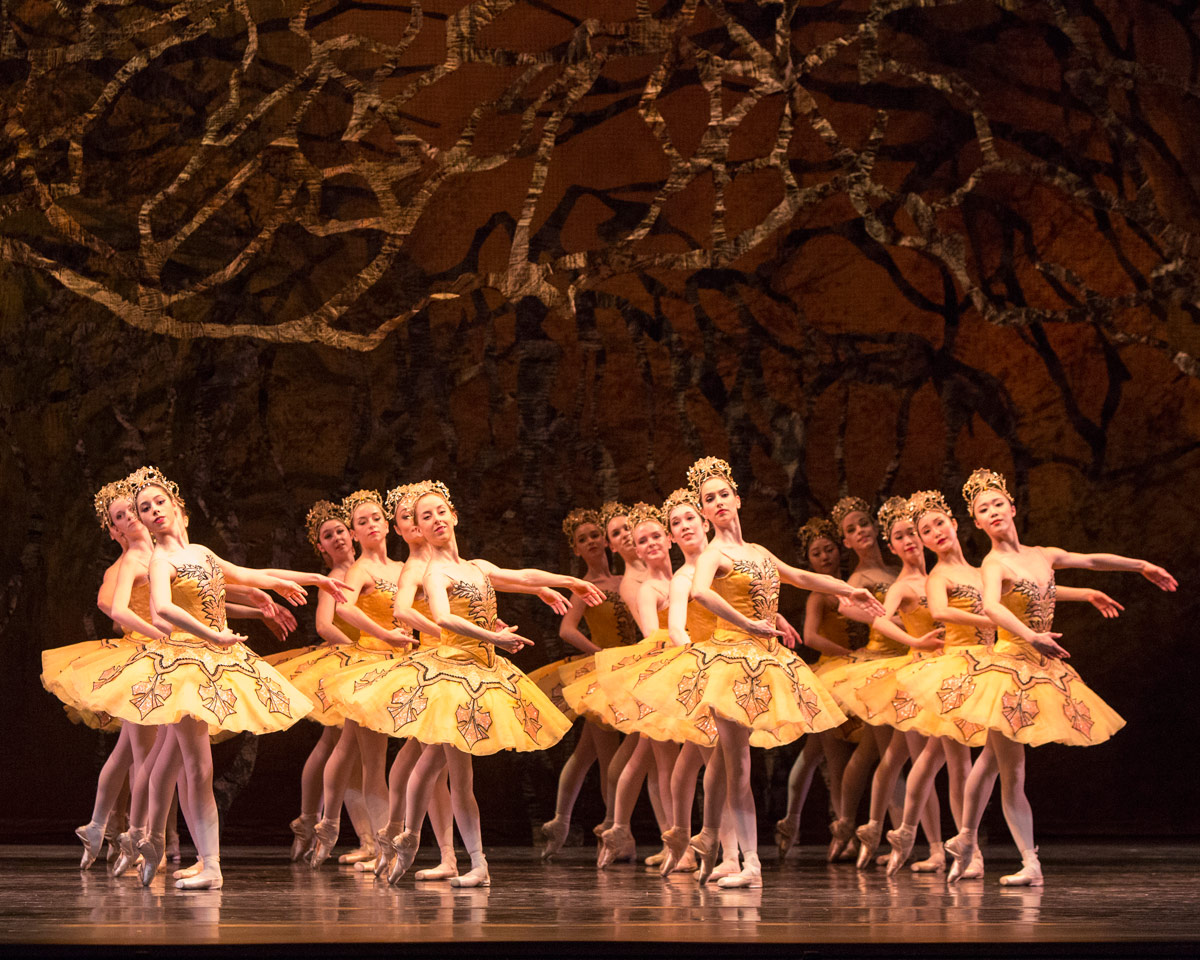
© Aleksandar Antonijevic. (Click image for larger version)
This Beauty makes for a spectacular showcase for the corps de ballet. From the enchanting ensembles of the Prologue to the dreamlike garlands of the Naiads in the Vision Scene and the final act’s festivities, the corps dancing was dedicated, polished and often superb.
Last but not least, the Tchaikovsky’s glorious score was given an excellent reading. The Orchestra led by guest conductor Geneviѐve Leclair played with brilliant sound, bringing to the fore the music’s crystalline qualities.













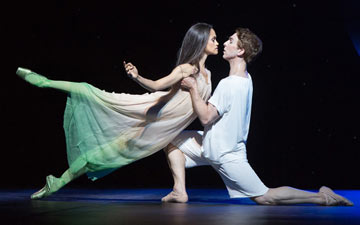
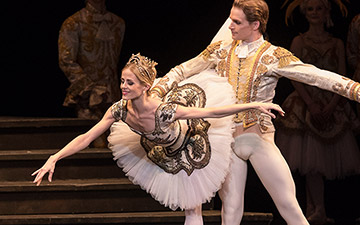
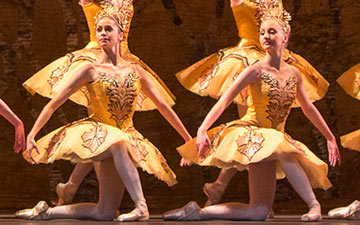
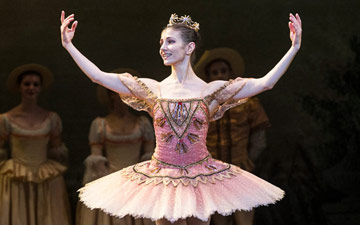
You must be logged in to post a comment.